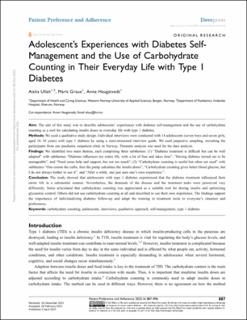| dc.description.abstract | Aim: The aim of this study was to describe adolescents’ experiences with diabetes self-management and the use of carbohydrate counting as a tool for calculating insulin doses in everyday life with type 1 diabetes.
Methods: We used a qualitative study design. Individual interviews were conducted with 14 adolescents (seven boys and seven girls, aged 16– 18 years) with type 1 diabetes by using a semi-structured interview guide. We used purposive sampling, recruiting the participants from one paediatric outpatient clinic in Norway. Thematic analysis was used for the data analysis.
Findings: We identified two main themes, each comprising three subthemes: (1) “Diabetes treatment is difficult but can be well adapted” with subthemes “Diabetes influences my entire life, with a lot of fuss and takes time”, “Having diabetes turned out to be manageable”, and “Need some help and support, but not too much”; (2) “Carbohydrate counting is useful but often not used” with subthemes “One counts the carbs, then the pump calculates the insulin doses”, “Carbohydrate counting gives better blood glucose, but I do not always bother to use it”, and “After a while, one just uses one’s own experience.”.
Conclusion: The study showed that adolescents with type 1 diabetes experienced that the diabetes treatment influenced their entire life in a substantial manner. Nevertheless, the demands of the disease and the treatment tasks were perceived very differently. Some articulated that carbohydrate counting was appreciated as a suitable tool for dosing insulin and optimizing glycaemic control. Others did not use carbohydrate counting at all and described to use their own experience. The findings support the importance of individualizing diabetes follow-up and adapt the training in treatment tools to everyone’s situation and preferences. | en_US |

